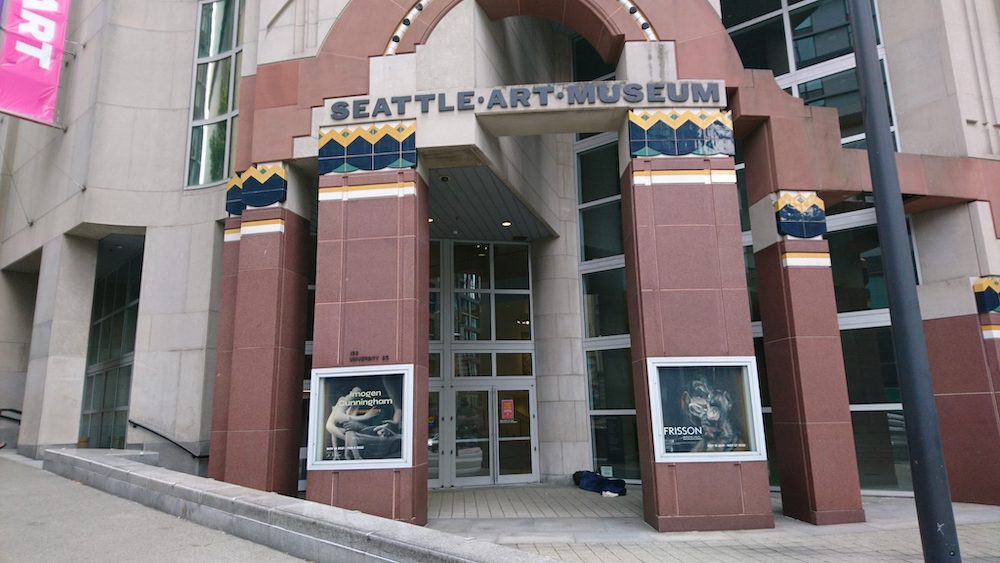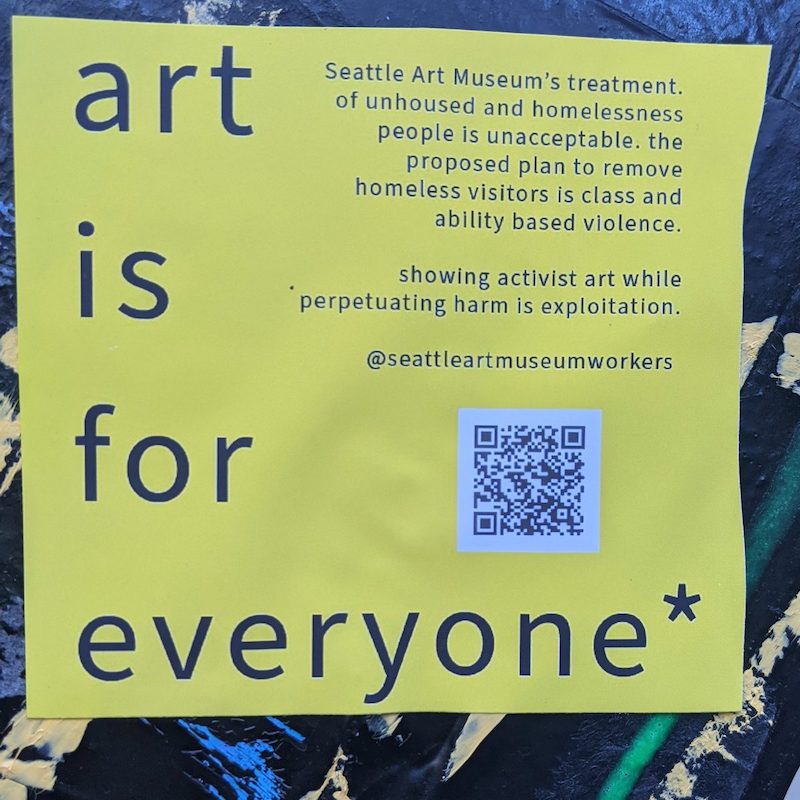Opinion
Seattle Museums Are Artwashing Their Way Back to “Normal”
As long as museums make representational rather than structural changes, they cannot shake off their white supremacist origins.
by Matthew Offenbacher
October 12, 2021

The Seattle Art Museum (2021) (photo by the author)
Seattle’s long-standing housing crisis became brutally worse these past two years, forcing thousands more to live in their cars and in public spaces. The number of tents in the city center has increased by more than 50%, a number that will keep growing as eviction moratoriums end and Amazon continues its inexorable expansion. As an artist living in this humanitarian disaster — while loved ones fell sick, democracy came apart, and the George Floyd / Breonna Taylor uprisings in my neighborhood were bombed by the police — I have had to rethink almost everything I thought I knew about art and community. With Seattle’s museums reopening, I hoped to see shifts in their priorities as well. Instead, some of them seem determined to revert to their worst selves.
In August, the Henry Art Gallery launched in their words, “an expansive group exhibition … set and performed in outdoor plazas and parks throughout downtown Seattle” to “explore the (re)activation of the physical body in our again-accessible public space.” With these words “our again-accessible public space,” the Henry (and partners On the Boards and Velocity Dance Center) erase the bodies they believe do not belong in “our” public spaces: the predominantly Black, Brown and Indigenous bodies that have been “accessing” these spaces all along by living there. The exhibition’s title Bodies of Discovery echoes justifications for colonial land seizure, and the sole funder is a business association that has made art part of an aggressive gentrification program couched in the language of cleanliness, beautification, and public hygiene.
I visited Occidental Square to see a sculpture that is part of Bodies of Discovery. Plopped down among other park “activations” including ping-pong tables and cafe chairs, it stood about 10 feet from where someone was sleeping on a huge pile of cardboard. The sculpture, a sheet metal flower coated with heat-sensitive paint and backed with plastic solar tubes, is not terrible. At least, it seemed aware of its absurdity in that context. I know that artists are caught in a double bind. Institutions are arbitrators of value and dispense scarce resources. I have come to believe, however, that an artwork’s self-awareness, or good intentions for healing, will wither in the depleted soil of an inhumane institutional frame.
Meanwhile, at the Seattle Art Museum, an anonymous group of frontline workers have been leaking documents and organizing online protests to highlight the museum’s bad-faith dealings with the houseless people who sleep at and near their downtown location. In June, museum administrators quietly made plans to hire private security and install hostile architecture in response to what they characterized as an “increase in physical violence and threats to our staff.” Upon learning of these plans, a group of visitor service officers (museum security guards) organizing under the name Decolonize SAM, launched a petition that suggested mutual aid-inspired alternatives in place of policing the museum’s perimeter. Their ideas included installing sharps containers, keeping basic supplies on hand like water, socks, protein bars, and transportation cards, and hiring a liaison who has experienced homelessness. These suggestions were disregarded. The resulting turmoil inside the museum, as revealed by the activists, has demonstrated levels of administrative ineptness that would be comical if they weren’t harmful.

Sticker by @seattleartmuseumworkers, now known as @decolonizesam (June 2021) (photo by Jennifer Nemhauser)
The private security force began their patrols at the end of August. One week later, their contract was terminated because of a series of aggressive interactions with unhoused people, culminating in a private security guard paying one unhoused person to steal the belongings of another. This hardening of SAM’s attitude towards its unhoused neighbors is bizarre considering the good relations frontline staff have cultivated in years past by making restrooms, lobbies, and galleries accessible as a refuge. It seems somehow symptomatic of museums in this moment that, at the same time SAM is resorting to these carceral methods, it is ramping up its diversity, equity and inclusion work by hiring a director of DEI and electing a Black woman to be chair of the board of trustees.
As long as museums make representational rather than structural changes, they cannot shake off their white supremacist origins. They will gravitate towards the politics of their funders, whose wealth and power almost guarantee an interest in maintaining the inequities of the status quo. They will respond to their paradoxical missions of taking care of people and taking care of property by deciding to stop seeing some groups of people as people. SAM’s new board chair said recently, “For me, every citizen of Seattle owns the art museum.” Lovely words, but they ring hollow when the museum’s actions show their commitment to community ends where being poor, without a house, or mentally ill begins. What is there to do? I can think of three things: Boycott specific institutions whose actions blatantly contradict their stated values (as Decolonize SAM is calling for); turn towards the places that are inventing new models for community (such as Wa Na Wari, STAHC or yəhaw̓ Indigenous Creatives Collective, to name just a few in Seattle). And — this one feels the hardest to me, as an artist who profoundly loves museums — stop believing in them altogether.